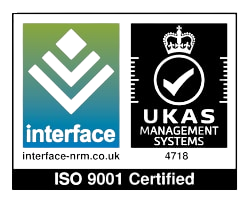Diagrammatic Pre-Employment Recruitment Tests 2024 | Full Guide
In this article, you can explore the importance of diagrammatic reasoning assessments in the recruitment process.
Are you involved in recruitment as a recruiter, talent acquisition specialist, HR expert, or hiring manager? Chances are, you’re already utilizing a diverse range of candidate assessment tools to swiftly identify and hire the most suitable candidates. These tools include aptitude tests, video interviews, assessment centres, and games.
If you are looking for answers to questions such as:
- What is a pre-employment diagrammatic reasoning test?
- How can diagrammatic reasoning tests be used in my company’s hiring process?
- How can diagrammatic reasoning tests help me find the best candidates?
- Why use diagrammatic reasoning pre-employment tests in hiring?
- Which roles are best suited for using diagrammatic reasoning tests?
- What are the benefits of using diagrammatic reasoning tests?
Then this text is for you. Continue reading to find the answers and much more.
Contents:
- What is a pre-employment diagrammatic reasoning assessment?
- What do diagrammatic reasoning tests for hiring measure?
- Types of diagrammatic reasoning tests.
- Examples of diagrammatic reasoning recruitment test questions.
- What industries make use of diagrammatic reasoning tests?
- Which roles and positions are best suited for recruitment using diagrammatic reasoning tests?
- How do recruiters interpret diagrammatic reasoning test results? What are percentile score marks?
- Benefits of using diagrammatic reasoning tests for hiring.
- What are some of the challenges or difficulties with using diagrammatic reasoning tests for recruitment?
- Diagrammatic reasoning assessments FAQs.
- Why use Assess Candidates’ pre-employment assessments to hire?
Continue reading to find the answers and much more.
1. What is a pre-employment diagrammatic reasoning assessment?
A pre-employment diagrammatic reasoning assessment is a type of cognitive aptitude test used in the hiring process. It evaluates a candidate’s ability to analyze and reason based on visual patterns and diagrams.

As a recruitment manager or talent acquisition expert, many jobs you advertise may require candidates to possess the ability to analyze diagrams or patterns, identify logical relationships, make inferences, and solve problems.
Diagrammatic reasoning tests are reliable and objective for predicting job performance, making them a preferred choice for employers in various fields, as we will soon cover below.
Having covered what diagrammatic reasoning tests are, let’s now understand what these tests measure.
Discover top talent with our pre-employment assessment tests. Hire For Free
2. What do diagrammatic reasoning tests for hiring measure?
Pre-employment diagrammatic reasoning assessments for hiring measure a range of cognitive skills and abilities. Here are 4 of the top skills they look at.
4 critical skills measured by diagrammatic reasoning tests
- Logical Reasoning: Assessing the candidate’s ability to identify and apply logical patterns, rules, and relationships within visual diagrams or sequences.
- Problem-Solving: Measuring the candidate’s capacity to analyze complex visual information and solve problems using logical reasoning.
- Visual Analysis: Assessing the candidate’s ability to visually analyze and compare diagrams or shapes, identifying similarities, differences, or transformations.
- Inductive Reasoning: Testing the candidate’s capability to infer and generalize information based on observed patterns and relationships in diagrams or sequences.

Why should diagrammatic reasoning pre-employment assessment tests be used in hiring?
Pre-employment diagrammatic test should be used in hiring for several reasons:
- Reduces hiring costs and risk of unsuccessful hires.
- Standardized questions for all candidates.
- Convenient online completion via email.
- Saves time and resources for the recruitment team.
- Provides objective, quantifiable data for candidate evaluation.
- Equal opportunities for candidates to demonstrate logical thinking skills.
How do diagrammatic reasoning tests differ from other assessments, such as numerical and verbal tests?
Let’s discover the different aspects of diagrammatic versus commonly used numerical and verbal tests.
| Assessment Type | What it Measures | What it Involves | What is Assessed |
|---|---|---|---|
| Diagrammatic Reasoning Test | Visual analysis, pattern recognition, logical reasoning | Analyzing visual diagrams, shapes, or sequences, identifying patterns and relationships, applying logical reasoning | Cognitive abilities, visual analysis skills, pattern recognition, problem-solving aptitude and analytical thinking |
| Numerical Tests | Numerical proficiency, mathematical skills | Solving mathematical calculations, interpreting data | Numerical skills, mathematical abilities, data interpretation |
| Verbal Tests | Language comprehension, reasoning skills | Reading and comprehending written passages, answering questions | Language comprehension, reasoning skills, critical thinking abilities |
By acknowledging the differences among these tests, recruiters gain the ability to evaluate candidates more efficiently, make well-informed hiring choices, and enhance their talent acquisition procedures.
We will now find out about some of the most common types of diagrammatic reasoning tests.
3. Types of diagrammatic reasoning tests.
Diagrammatic reasoning tests assess visual analysis and interpretation skills. They present diagrams or patterns for identifying patterns, relationships, and rules. Common types include:
- Sequence or Series Tests: Identify the correct diagram that follows a logical sequence.
- Analogies: Determine the relationship between a pair of diagrams and find the matching relationship in another pair.
- Classification Tests: Identify the odd one out among a group of diagrams based on common features.
- Matrix Tests: Complete a grid of diagrams based on the patterns and rules applied horizontally and vertically.
- Spatial Reasoning Tests: Assess mental manipulation and visualization of objects in space.
- Inference Tests: Draw logical conclusions based on given diagrams or patterns.
- Data Sufficiency Tests: Determine which statements provide enough information to understand the rules or relationships within the diagrams.
The terminology for different types of diagrammatic reasoning tests may vary depending on the publisher or assessment provider.
Here are some examples of diagrammatic reasoning test questions.
4. Examples of diagrammatic reasoning recruitment test questions.
Below we provide pre-employment diagrammatic reasoning test questions with worked solutions to help you visualize and understand the problem-solving process faced by candidates.
Example 1
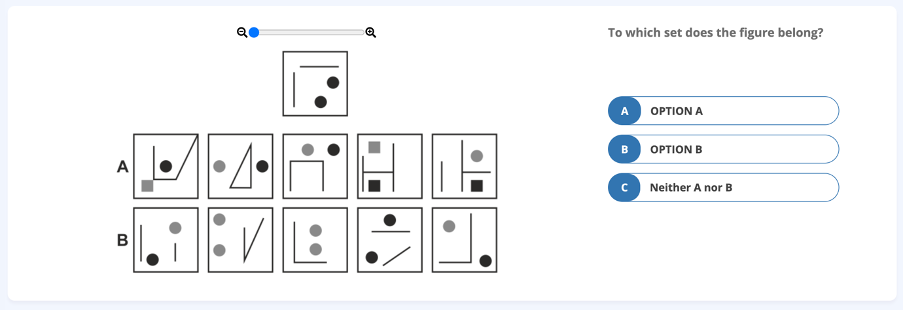
- Task: The candidate must identify to which set the figure belongs.
- Solution:
- Boxes in Set A contain 3 lines and boxes in Set B contain 2 lines. Furthermore, boxes in set A always contain one black and one grey shape, whereas set B always contains two circles.
- Since the new figure has two lines and two circles, B is the correct answer.
Example 2
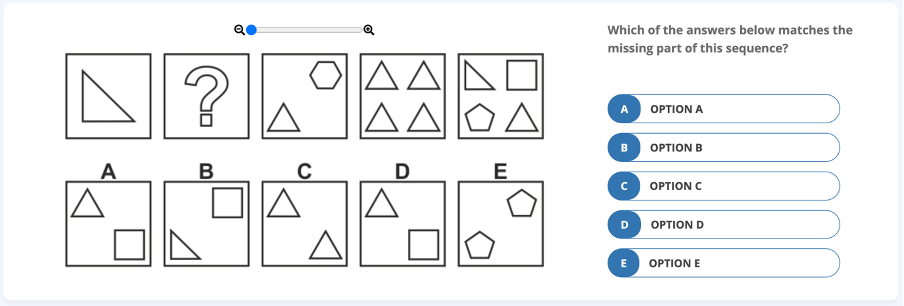
- Task: The candidate must identify which of the answers below matches the missing part of this sequence.
- Solution:
- Across the sequence, the sum of edges of all shapes increases by 3 in every diagram.
- Therefore the right answer should have a total number of edges on all shapes equal to 6, giving C as the correct answer.
Example 3
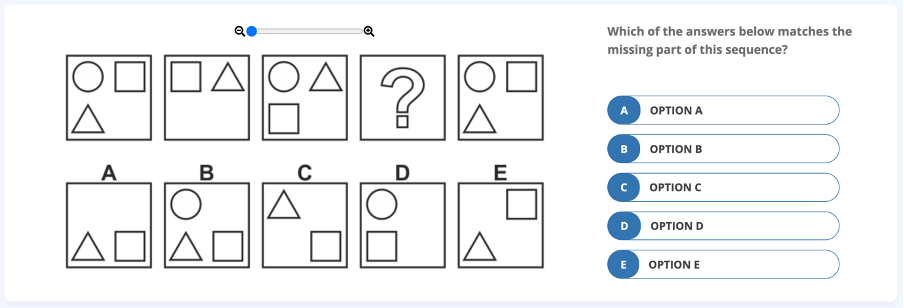
- Task: The candidate must identify which of the answers below matches the missing part of this sequence.
- Solution:
- Across the diagram the square moves by one position anticlockwise around the edges of the diagram and can cover other shapes, whereas the triangle moves by two positions clockwise every second diagram.
- The circle appears in every second diagram. Therefore A is the correct answer.
Average time per question: 60 seconds
The diagrammatic test typically contains 10-40 questions.
Next, we will delve into the industries that make use of diagrammatic reasoning tests.
5. What industries make use of diagrammatic reasoning tests?
Diagrammatic reasoning tests are commonly used in various industries to assess a candidate’s logical reasoning and problem-solving abilities.
Some industries that make use of diagrammatic reasoning tests include:
- Consulting and professional services: Tests evaluate analytical skills and critical thinking in candidate selection.
- Information Technology (IT): Tests assess logical and abstract reasoning skills in candidates for software development, system analysis, data analysis, or IT consulting roles.
- Engineering and technical fields: Tests evaluate candidates’ ability in analyzing complex systems, understand technical diagrams, and solve problems efficiently.
- Financial services: Tests assess candidates’ logical thinking, numerical reasoning, and attention to detail, especially for roles in risk analysis, quantitative finance, or financial consulting.
- Research and Development: Tests assess candidates’ ability to analyze complex data, think critically, and generate innovative solutions in scientific research, pharmaceuticals, and innovation.
Let’s explore the job roles and positions that are especially suitable for recruitment through diagrammatic reasoning tests.
6. Which roles and positions are best suited for recruitment using diagrammatic reasoning tests?
Diagrammatic reasoning tests are ideal for assessing candidates for roles requiring strong analytical skills, critical thinking, and problem-solving. Examples of such roles include
| Roles and Positions | Skills Assessed |
| Management Consultant | Analytical thinking, critical reasoning |
| Analysts | Numerical reasoning, logical deduction |
| Software Developer | Abstract reasoning, problem-solving |
| Research Scientist | Data interpretation, logical reasoning |
| Product Development Specialist | Innovative thinking, problem-solving |
Diagrammatic reasoning tests can assess a wide range of skills across various roles and positions.
In our upcoming section, you will discover how to interpret diagrammatic reasoning test results and comprehend the significance of percentile score marks.
Find the perfect fit for your organization with our end-to-end pre-employment assessment tests. View Plans
7. How do recruiters interpret diagrammatic reasoning test results? What are percentile score marks?
Recruiters analyze the results of the diagrammatic thinking test by reviewing the percentile score marks.
Interpreting diagrammatic reasoning test results involves comparing a candidate’s performance to a norm group, with higher percentile scores indicating stronger performance and lower scores indicating weaker performance.
For example, if a candidate has a percentile score of 80, it means they performed better than 80% of the norm group.

Percentile scores offer insights into a candidate’s relative strengths and weaknesses in diagrammatic reasoning.
Here are some general guidelines for interpreting percentile scores on diagrammatic reasoning tests:
- Above 90th Percentile: Exceptional performance, strong analytical and logical reasoning skills, quick pattern recognition, and accurate inference abilities.
- 75th to 90th Percentile: Above-average performance, good problem-solving abilities, a solid understanding of visual patterns, and effective analysis of diagrams.
- 50th to 75th Percentile: Average performance, satisfactory diagrammatic reasoning skills for basic tasks.
- 25th to 50th Percentile: Below-average performance, weaker diagrammatic reasoning skills, complex pattern recognition, and accurate deduction challenges.
- Below 25th Percentile: Poor performance, difficulty understanding visual patterns, analyzing relationships, and making logical deductions.
Remember: Pre-employment diagrammatic reasoning tests are useful as an initial filtering tool. Setting a lower cut-off around the 30th percentile ensures a basic standard of performance. Further stages can be added to assess the candidate’s suitability for the role.
Read on to learn more about the advantages of employing diagrammatic reasoning tests for you and your company.
Make informed hiring decisions with our reliable pre-employment assessment tests. Hire For Free
8. Benefits of using diagrammatic reasoning tests for hiring.
Diagrammatic tests assess cognitive abilities crucial for roles involving complex data analysis, problem-solving, and decision-making.
Here are 5 top reasons for incorporating diagrammatic reasoning tests in the hiring process:
- Assessing cognitive abilities: Tests evaluate skills like analytical thinking, logical reasoning, problem-solving, and pattern recognition.
Example: For a data analyst position, candidates are required to take a diagrammatic reasoning test to assess their ability to analyze complex charts and graphs, identify patterns and draw logical conclusions.
- Standardized evaluation: These tests provide an objective and consistent evaluation method, ensuring fair and unbiased comparisons among candidates.
Example: A company administers a standardized diagrammatic reasoning test for software engineering candidates, evaluating their ability to analyze shapes and patterns through visual puzzles.
- Predictive validity: High diagrammatic test scores correlate with job success, predicting a candidate’s potential in similar workplace tasks.
Example: A company includes these tests in their hiring process to identify candidates with the potential for excellence in complex project management tasks where an eye for spotting patterns is required.
- Efficiency in screening candidates: Diagrammatic tests effectively identify candidates with necessary cognitive abilities, saving time and resources by focusing on those demonstrating potential through test performance.
Example: A large organization employs a diagrammatic reasoning test to screen candidates for an entry-level analyst position. Those meeting a score threshold proceed in the hiring process, reducing the candidate pool.
- Objective comparison: Benchmarking scores against a norm group allows recruiters to compare candidates’ performance objectively, informing assessments and decisions.
Example: A multinational company hiring marketing strategists in various regions utilizes region-specific norm groups to compare candidates’ percentile scores on a diagrammatic reasoning test.
Despite the valuable insights that diagrammatic reasoning tests bring, there are drawbacks. Let’s cover these in some more detail.
9. What are some of the challenges or difficulties with using diagrammatic reasoning tests for recruitment?
Here are 5 questions often asked when it comes to the limitations of diagrammatic reasoning tests in the recruitment process.
5 Limitations of Diagrammatic Reasoning Tests
- Are diagrammatic reasoning tests the most accurate measure of job performance?
- Tests assess cognitive abilities but may not directly correlate with specific job skills you require that demonstrate performance.
Solution: Organizations should use an assessment process that taps into behavioural competence and preferences as well as the technical ability alone. This can help to gain a comprehensive understanding of candidates’ skills, knowledge, and experience.
- Do diagrammatic reasoning tests introduce bias?
- The test format and visuals may introduce bias due to favouring certain demographics or individuals with specific educational backgrounds.
Solution: Collaboration with test providers can allow you to create norm groups based on different populations. Thus, candidates are compared against those similar to them and potentially unfair comparisons are avoided.
- Are diagrammatic reasoning tests suitable for all job roles?
- Roles requiring creativity, emotional intelligence, or specialized knowledge may not be accurately evaluated through these tests alone.
Solution: Incorporate practical exercises, case studies, or behavioural assessments to evaluate creativity, emotional intelligence, and domain-specific knowledge.
- Can test familiarity impact results?
- Familiarity with diagrammatic reasoning tests may provide an advantage, affecting fairness and accuracy. It may not solely reflect a candidate’s true cognitive abilities.

Solution: A common misconception, practising these tests simply reduces the error variable such as test anxiety, allowing candidates to realise their true score. This is unlikely to provide candidates with significantly added ability. Still, best practice is to supplement any assessment with other tests to get an overall picture of a candidate. The process must be end-to-end.
- How does test anxiety affect performance?
Test anxiety can hinder candidates’ performance on diagrammatic reasoning tests, impacting their cognitive abilities and potentially yielding inaccurate results.
Solution: Organizations can create a supportive testing environment by providing clear instructions, ample preparation time, and information about the test format to reduce test anxiety.
We have now covered all there is to know about pre-employment diagrammatic reasoning tests. Here are some commonly asked FAQs about this assessment type.
10. Diagrammatic reasoning assessments FAQs.
Here are some frequently asked questions that offer recruiters a comprehensive understanding of the purpose and considerations regarding the utilization of diagrammatic reasoning tests in the pre-employment recruitment process.
- What are diagrammatic reasoning tests used for recruitment?
- Diagrammatic reasoning tests assess cognitive abilities relevant to roles involving data analysis, problem-solving, and decision-making in recruitment.
- Can candidates prepare for diagrammatic reasoning tests?
- Candidates cannot improve, rather reduce the error in their score, through diagrammatic reasoning test practice and familiarity with the test format.
- Are diagrammatic reasoning tests suitable for all job roles?
- Diagrammatic reasoning tests may not be suitable for all job roles as they primarily assess cognitive abilities and may not capture other important softer skills. Tailoring assessments to specific job requirements is recommended for a comprehensive evaluation of candidate performance.
- Do diagrammatic reasoning tests accurately predict job performance?
- Diagrammatic reasoning tests have predictive validity, but they may not solely determine job performance. Other factors, like experience and interpersonal skills, also contribute. Thus, it is important to ensure your assessment process is end-to-end and captures preferences, behavioural competence as well as the technical aspect of performance.
- Can diagrammatic reasoning tests be used for internal promotions or career development?
- Diagrammatic reasoning tests may provide an initial insight into how an employee is doing but should not be used to inform promotions alone. Rather, evaluations such as 360 feedback and encompassing a variety of assessment methods is preferred to build an overall picture of how an employee is performing.
Lastly, let’s examine why integrating Assess Candidates’ pre-employment assessments into the hiring process can help you select top talent.
11. Why should Assess Candidates’ pre-employment assessments be incorporated into the hiring process?
At Assess Candidates we provide a range of psychometric assessments to suit all organisation’s needs.
Below is an example of our reporting tool on Assess Candidates, that you as a hiring manager or talent acquisition expert will see when reviewing candidate performance.
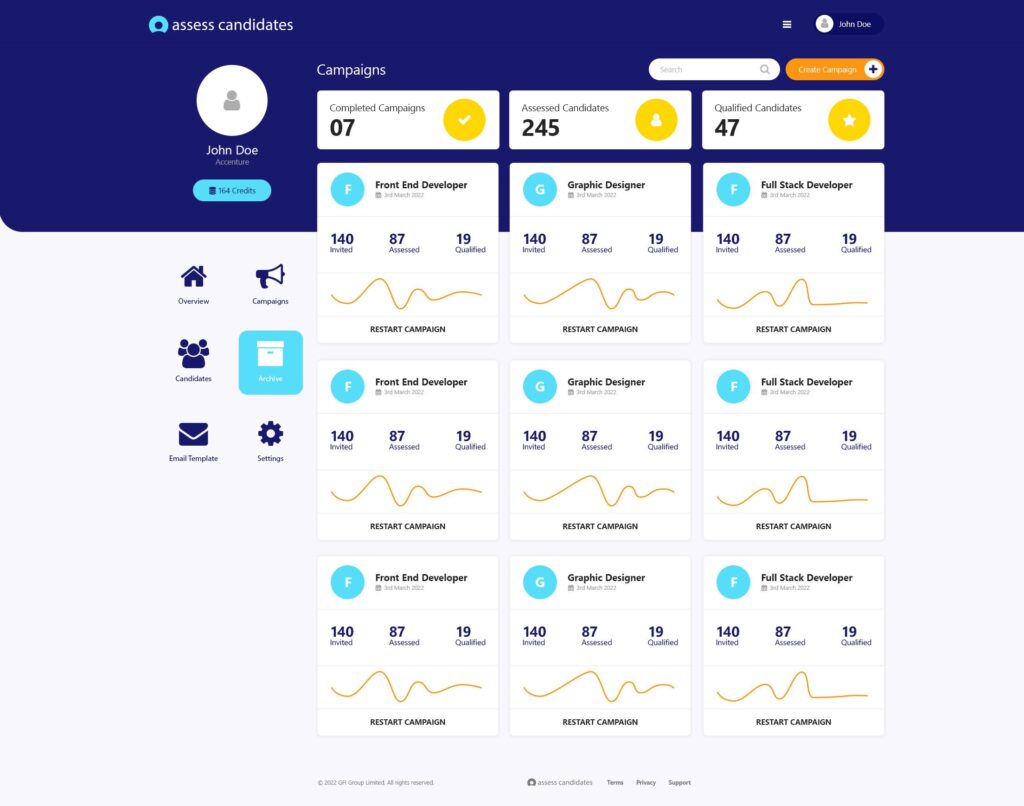
Top 4 reasons to choose Assess Candidates:
- Top industry tests developed by experienced psychologists.
- Experienced psychologists develop AC’s psychometric assessments specialized in psychometrics.
- Our experts have developed assessments for leading companies like SHL and IBM Kenexa.
- Tests are valid, reliable, and accurately measure job-related traits and abilities.
- Employers can have confidence in the quality and effectiveness of the assessment tools
- Hiring Assessment Platform Compatibility:
- Compatible with hiring assessment platform for a seamless hiring process.
- Easy administration and tracking within existing recruitment software.
- Saves time and effort for employers.
- Enables smooth data management and integration of assessment results.
- Providing an engaging experience for candidates:
- User-friendly, intuitive, and visually appealing assessments.
- Enhances candidate engagement and reduces test anxiety.
- Helps candidates perform at their best and showcase their true abilities.
- Leads to a fair and accurate evaluation of skills and suitability for the role.
- Candidate Accessibility Support
- Designed to accommodate individuals with different abilities.
- Provides accessibility support (e.g., screen reader compatibility)
- Ensures equal participation in the assessment process.
